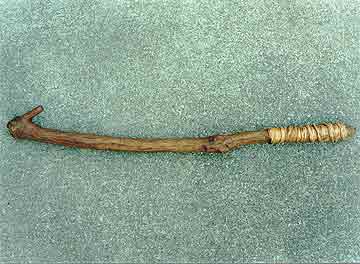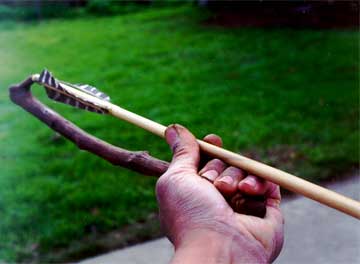
The atlatl was used for thousands of years almost worldwide. It had the advantage of lengthening the throwing arm of the hunter, thus more leverage to increase the speed of the dart. Despite the worldwide variations in the design of the atlatl, the basic components are still the same. They all incorporate a handle connected to a shaft with a spur.
A simple atlatl can be made from a tree branch. Look for a straight branch with a smaller side branch extending out at an angle. An ideal angle for the smaller side branch would be 40 to 45 degrees from the main branch. Less than 40 degrees would work, but the smaller branch should not be parallel and lay flat to the main branch. The diameter of the smaller branch, which will become the spur, should fit the size of the notch hole on your dart. Also, be sure that the main branch is large and comfortable enough to fit in your hand. Too small of a size will be unstable during the throwing of the dart. The length of your simple atlatl is subjective, although I would not go smaller than 11 inches. Various type of woods may be used for your atlatl. Try not to get a branch that is too soft and too flexible.


A completed atlatl made from an oak branch. The handle may
be wrapped to provide a better grip. The handle of the oak atlatl
was wrapped with split pine root. You may also use buckskin or
willow bark for the handle wrapping. Experiment with different
materials.
Another alternative for the handle, besides wrapping, would be
to shave or cut the top side of the handle flat. Leave the bottom
side in its natural rounded shape. The flat surface will provide
a better gripping surface than a rounded surface.

When looking for that atlatl branch, be mindful of the environment and the tree in which you will be harvesting the branch. Will the tree survive the cutting? Is that branch providing shelter for other flora and fauna. Am I gathering on private property? In the excitement of looking for that perfect branch, don't let our own desires overpower our common sense.
E-mail your comments to "Dino Labiste" at KahikoArts@yahoo.com
We hope the information on the PrimitiveWays website is both instructional and enjoyable. Understand that no warranty or guarantee is included. We expect adults to act responsibly and children to be supervised by a responsible adult. If you use the information on this site to create your own projects or if you try techniques described on PrimitiveWays, behave in accordance with applicable laws, and think about the sustainability of natural resources. Using tools or techniques described on PrimitiveWays can be dangerous with exposure to heavy, sharp or pointed objects, fire, stone tools and hazards present in outdoor settings. Without proper care and caution, or if done incorrectly, there is a risk of property damage, personal injury or even death. So, be advised: Anyone using any information provided on the PrimitiveWays website assumes responsibility for using proper care and caution to protect property, the life, health and safety of himself or herself and all others. He or she expressly assumes all risk of harm or damage to all persons or property proximately caused by the use of this information.
© PrimitiveWays 2017